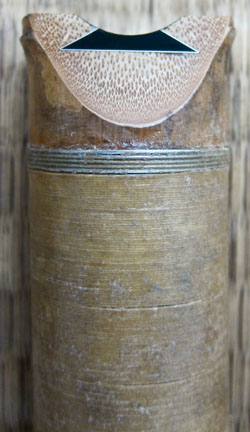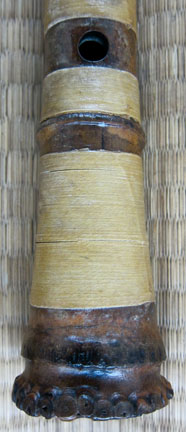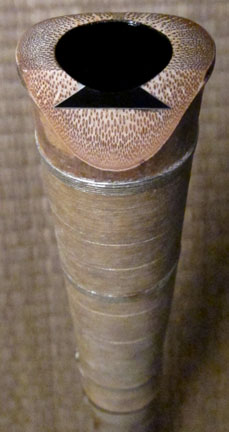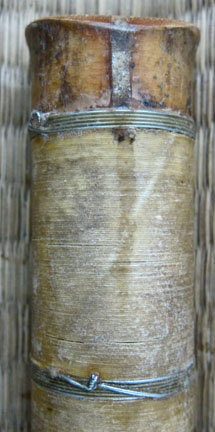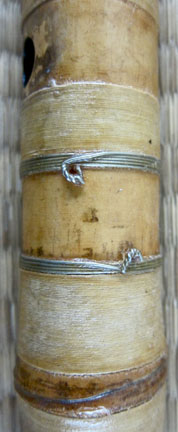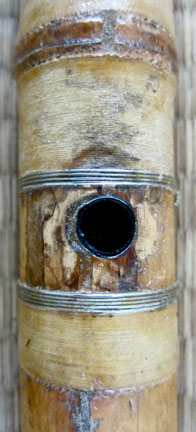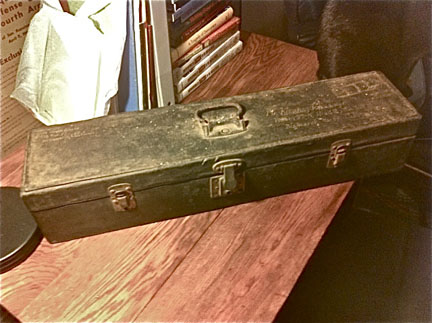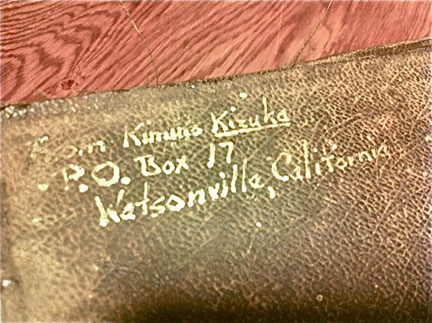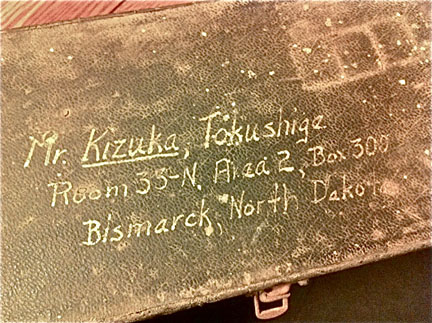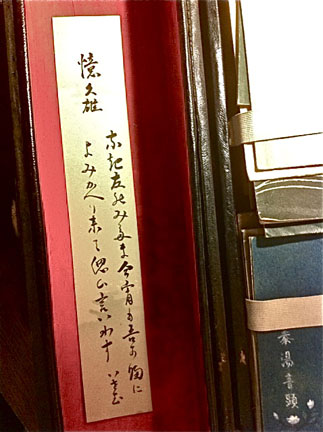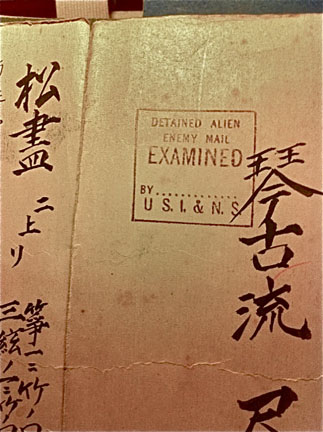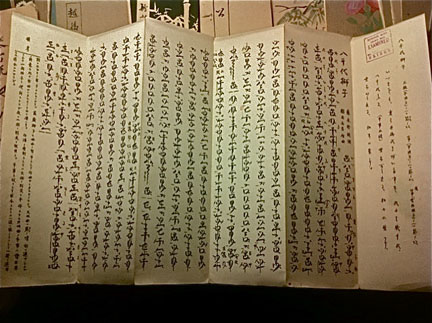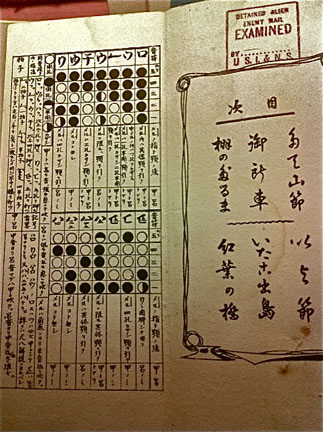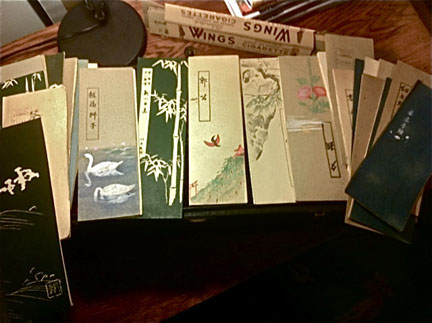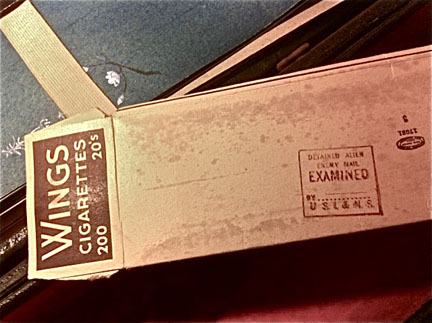|
VINTAGE SHAKUHACHI Repair & Restoration • Performance Upgrade |
|
|
Restoration of 1.8' Shakuhachi Rescued from a WWII-era Japanese Internment Camp When this shakuhachi was sent to me for evaluation and possible restoration, it was in a devastated condition. The utaguchi inlay was missing and the mouthpiece broken and chipped. Of greater concern, however, was the madaké bamboo which had huge gaping cracks that penetrated into the interior bore. In all my years making shakuhachi, I had never received a flute in such terrible condition. In spite of its compromised state, it was obvious that, at some point in the past, a great effort was made to keep this instrument in a playable condition. Most of the bamboo was hidden behind thin string binding and reinforced with twisted steel wires at critical places along the culm. Whoever had undertaken this work clearly had limited resources at their disposal, but made a valiant effort to keep this shakuhachi alive. Common sense told me to abandon the project as it would take an immense amount of effort to get his instrument back to a playable condition, without any guarantee how successful the outcome would be. Something about the flute, however, urged me on and I was compelled to take up the challenge.
A Long and Incredible Journey The shakuhachi was sent to me by Mr. Stanley Oda through a third party who knew of my restoration work. When I contacted Mr. Oda directly, the remarkable story of this bamboo flute and how it came into his possession revealed itself to me. Mr. Oda's parents and several family members were interned in the relocation camps established by Executive Order 9066 in 1942 after the bombing of Pearl Harbor and the onset of World War II. Over 110,000 loyal American citizens of Japanese descent who lived along the Pacific Coast (including all of California and most of Oregon and Washington) were forced to abandon their homes, business and lives and incarcerated in concentrations camps set up in remote areas throughout the country. Locked behind barbed wire, internees had to face severe and harsh conditions of life, stripped of all their rights as American citizens and dignity as human beings. It took the American government nearly half a century to acknowledge and apologize for this shameful epoch in our nation's history. In 1988, Congress and President Regan passed legislation acknowledging our government's wrong doing and expressing regret for the internment of its Japanese-American citizens, citing implementation of policies based on " race prejudice, war hysteria, and a failure of political leadership." Here are Stanley Oda's own words:
The History of this Internment Camp Shakuhachi Information pieced together by Stanley Oda from US government archives and information provided by the seller, supplemented by an Internet search I conducted, revealed that shakuhachi was owned by Mr. Tokushige Kizuka of Watsonville, California.
According to records of the War Relocation Authority ID #12280, the Kizuka family included Tokushige's wife and three children. Wife, Kimino, was born in Japan in 1902 and came to America in 1915. Eldest son, Shigeru, was born in 1923. The other two children included a son, Makio, born in 1931 and a daughter, Reiko, born in 1932. Tokushige Kizuka was born in Japan, but emigrated to America to operate and manage a strawberry farm in central California. He rose to became an respected and prominent member of the Japanese-American immigrant community in Watsonville. This would explain why the Department of Justice imprisoned him. At the outbreak of the war, they rounded up influential Issei (first generation immigrants) who were community and religious leaders and businessmen. Mr. Kizuka was interned for the duration of the war. There is no record of him being sent to rejoin his family in Poston during this time. Mr. Kizuka's son Shigeru, 18 years old at the time, recalled in a memoir entitled "Life During War Time", after having their home ransacked and torn apart by the FBI, his father was taken away and not seen again until the war's end. The family did not learn his whereabouts for several weeks. Shigeru missed his own high school graduation because he was behind barbed wire. He is the one who sent the shakuhachi to his father. Since most Japanese-American families had only a few weeks to sell their belongings before being interned, and could take only what they could carry in a suitcase, this shakuhachi could be one of the few pre-war family possessions that have survived. Here are photos of the shakuhachi case and sheet music mailed by Shigeru to his father.
Epilogue After considerable effort Tokushige Kizuka's shakuhachi was restored to a playable condition. One can only guess how many years it had remained silent during it's long and remarkable journey from Japan to central California, through the WWII internment camps in North Dakota and New Mexico, to my workshop in northern California. Today, this journey resumed as I sent off the shakuhachi to Stanley Oda in Chicago. It's initial tone and resonance were weak and halting, however, hearing it sing once again was a profound and somewhat emotional moment for me. In spite of its feeble voice, I sensed that this shakuhachi had once been a very fine instrument, so after repairing and restoring the bamboo, continued work to reconstructing its interior bore, the most critical part of any shakuhachi that largely determines its acoustical and performance qualities. When the full restoration was finally completed, the end result was a remarkable culmination to the incredible story of Kizuka-san's shakuhachi. It played with great sensitivity, producing a rich and resonant tone comparable to some of the finest professional-level instruments I have made or have had the opportunity to play. It is truly a remarkable shakuhachi. As I write, this instrument is once again in transit, to a new life and owner who will embraced it with reverence and respect it so greatly deserves. I sincerely appreciate the opportunity and trust placed in me to be a midwife to its rebirth. Monty PS I learned that the organizational headquarters of the Japanese-American Citizens League of Watsonville-Santa Cruz, California was been named to honor the memory of Tokushige Kizuka. http://www.watsonvillesantacruzjacl.org/includes/9-2008news.pdf |
||||||||||||||||||||||||
In 2014, the restored Kizuka shakuhachi used in performance on
HIDDEN LEGACY: Japanese Traditional Performing Arts in the WWII Camps



